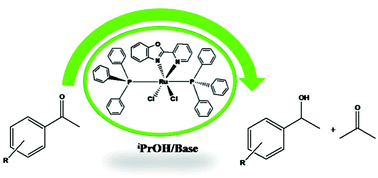(Pyridyl)benzoazole ruthenium(ii) and ruthenium(iii) complexes: role of heteroatom and ancillary phosphine ligand in the transfer hydrogenation of ketones†
Abstract
The synthesis and structural characterization of ruthenium complexes supported by 2-(2-pyridyl)benzoazole ligands and their evaluation as catalysts in the transfer hydrogenation of ketones are reported. Reactions of 2-(2-pyridyl)benzoimidazole (L1), 2-(2-pyridyl)benzothiazole (L2) and 2-(2-pyridyl)benzoxazole (L3) with RuCl3·3H2O produced the corresponding complexes [RuCl3(L1)] (1), [RuCl3(L2)] (2) and [RuCl3(L3)] (3), respectively. Similarly, treatment of L1–L3 with RuCl2(PPh3)2 afforded the corresponding Ru(II) complexes [RuCl2(PPh3)2(L1)] (4), [RuCl2(PPh3)2(L2)] (5) and [RuCl2(PPh3)2(L3)] (6), respectively. Solid state structures of 1 and 2 confirmed the bidentate coordination mode of L1 and L2 to ruthenium. 31P{1H} NMR spectroscopy revealed coordination of two PPh3 ligands trans to each other in an octahedral environment in 4–6 as confirmed by the solid state structure of 6. Complexes 1–6 produced active catalysts in the transfer hydrogenation of ketones in 2-propanol at 82 °C. Ruthenium(II) complexes 4–6, containing the PPh3 ligand, exhibited higher catalytic activities than the corresponding ruthenium(III) compounds 1–3. Complexes 1 and 4 of L1 were more active than the corresponding complexes of L2 and L3. Density functional theoretical calculations showed that dipole moments of 1–6 control their catalytic activities.


 Please wait while we load your content...
Please wait while we load your content...